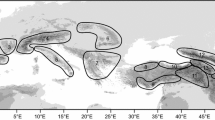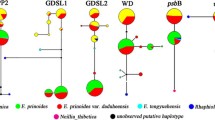Abstract
A few individuals with intermediate morphology always appeared in the sympatric distributions of Gentiana straminea and G. siphonantha. These intermediate individuals were hypothesized to be the hybrids of two species after a careful evaluation of their morphological characteristics. To test this hypothesis, sequence comparison of the internal transcribed spacer (ITS) regions of the nuclear ribosomal and trnS (GCU)-trnG (UCC) intergenic spacer region of the chloroplast DNA from Gentiana straminea, G. siphonantha and the putative hybrids was performed. The results suggest that most intermediate individuals were the natural hybrids between G. straminea and G. siphonantha. In addition, we examined the sequence variation among the individuals of both parent species and analyzed the possibility leading to the incongruent identification in some individuals based on morphologic and molecular evidences, respectively. The intraspecific diversification of DNA fragments within both parent species and their high variability in hybrid swarms probably resulted from chloroplast genome recombination and incomplete lineage sorting during the early stages of speciation origin of the parent species.
Similar content being viewed by others
References
Arnold M L (1997). Natural Hybridization and Evolution. New York: Oxford University Press
Arnold M L, Bouck A C, Cornman R S (2003). Verne Grant and Louisiana irises: is there anything new under the sun? New Phytologist, 161(1): 143–149
Chen S Y, Chen S L, Xia T, Wang Y J (2005). Phylogeny of Metagentiana and related genera (Gentianaceae) inferred from nuclear ribosomal ITS sequences. Acta Phytotaxonomica Sinica, 43(6): 491–502 (in Chinese)
Doyle J J, Doyle J L (1987). A rapid DNA isolation procedure for small quantities of fresh leaf material. Phytochemical Bulletin, 19(6): 11–15
Ellstrand N C, Whitkus R W, Rieseberg L H (1996). Distribution of spontaneous plant hybrids. Proceedings of the National Academy of Sciences of the United States of America, 9310, 50905093
Ferris C, King R A, Gray A J (1997). Molecular evidence for the maternal parentage in the hybrid origin of Spartina anglica C. E. Hubbard. Molecular Ecology, 6(2): 185–187
Grant V (1981). Plant speciation. New York, USA: Columbia University Press
Hamilton M B (1999). Four primer pairs for the amplification of chloroplast intergenic regions with intraspecific variation. Molecular Ecology, 8(3): 521–523
Harris S A, Ingram R (1991). Chloroplast DNA and biosystematics: the effect of intraspecific diversity and plastid transmission. Taxon, 40(3): 393–412
Ho T N, Liu S W (2001). A worldwide monograph of Gentiana. Beijing: Science Press (in Chinese)
Koch M A, Dobes C, Mitchell-Olds T (2003). Multiple hybrid formation in natural populations: concerted evolution of the internal transcribed spacer of nuclear ribosomal DNA (ITS) in North American Arabis divaricarpa (Brassicaceae). Molecular Biology and Evolution, 20(3): 338–350
Lexer C, Welch M, Raymond O, Rieseberg L H (2003). The origins of ecological divergence in Helianthus paradoxus (Asteraceae): Selection on transgressive characters in a novel hybrid habitat. Evolution, 57(9): 1989–2000
Liu J Q, Wang Y J, Wang A L, Ohba H, Abbott R J (2006). Radiation and diversification within the Ligularia-Cremanthodium-Parasenecio complex (Asteraceae) triggered by uplift of the Qinghai-Tibetan Plateau. Molecular Phylogenetics and Evolution, 38(1): 31–49
Mansiona G, Struwe L (2004). Generic delimitation and phylogenetic relationships within the subtribe Chironiinae (Chironieae: Gentianaceae), with special reference to Centaurium: evidence from nrDNA and cpDNA sequences. Molecular Phylogenetics and Evolution, 32(3): 951–977
Mogensen H L (1996). The hows and whys of cytoplasmic inheritance in seed plants [J]. American Journal of Botany, 83(3): 383–404
Pringle J S (1965). Hybridization in Gentiana (Gentianaceae): a resume of J.T. Curtis’ studies. Transactions of the Wisconsin Academy of Sciences, Arts and Letters, 54(3): 283–293
Rauscher J T, Doyle J J, Brown A H D (2002). Internal transcribed spacer repeat-specific primers and the analysis of hybridization in the Glycine tomentella (Leguminosae) polyploid complex. Molecular Ecology, 11(12): 2691–2702
Rieseberg L H (1995). The role of hybridization in evolution: old wine in new skins. American Journal of Botany, 82(7): 944–944
Rieseberg L H, Carney S E (1998). Plant hybridization. New Phytologist, 140(4): 599–624
Rieseberg L H, Archer M A, Wayne R K (1999). Transgressive segregation, adaptation, and speciation. Heredity, 83(4): 363–372
Rieseberg L H, Raymond O, Rosenthal D M, Lai Z, Livingstone K, Nakazato T, Durphy J L, Schwarzbach A E, Donovan L A, Lexer C (2003). Major Ecological Transitions in Wild Sunflowers Facilitated by Hybridization. Science, 301(5637): 1211–1216
Rieseberg L H, Wood T E, Baack E J (2006). The nature of plant species. Nature, 440(7083): 524–527
Schwarzbach A E, Donovan L A, Rieseberg L H (2001). Transgressive character expression in a hybrid sunflower species. American Journal of Botany, 88(2): 270–277
Stebbins G L (1959). The role of hybridization in evolution. Proceedings of the American Philosophical Society, 103(4): 231–251
Swofford D L (2000). PAUP*. Phylogenetic Analysis Using Parsimony (3 and Other Methods). Version 4.0b10. Sunder land, MA: Sinauer Associates
Thompson J D, Gibson T J, Plewniak F, Jeanmouqin F, Higgins D G (1997). The Clustal X windows interface: flexible strategies for multiple sequence alignment aided by quality analysis tools. Nucleic Acids Research, 25(24): 4876–4882
Tsukaya H, Fukuda T, Yokoyama J (2003). Hybridization and introgression between Callicarpa japonica and C. mollis (Verbenaceae) in central Japan as inferred from nuclear and chloroplast DNA sequences. Molecular Ecology, 12(11): 3003–3011
Wang A L, Yang M H, Liu J Q (2005). Molecular Phylogeny, recent radiation and evolution of gross morphology of the Rhubarb genus Rheum (Polygonaceae) inferred from chloroplast DNA trnL-F sequences. Annals of Botany, 96(3): 489–498
Wang Y J, Li X J, Hao G, Liu J Q (2004). Molecular phylogeny and biogeography of Androsace (Primulaceae) and the convergent evolution of cushion morphology. Acta Phytotaxonomica Sinica, 42(6): 481–499 (in Chinese)
Wendel J F, Schnabel A, Seelanan T (1995). Bidirectional interlocus concerted evolution following allopolyploid speciation in cotton (Gossypium). Proceedings of the National Academy of Sciences of the United States of America, 92(1): 280–284
White T J, Bruns T, Lee S, Taylor J (1990). Amplification and direct sequencing of fungal ribosomal RNA genes for phylogenetics. In: Innis M, Gelfand D, Sninsky J, White T, eds. PCR Protocols: A Guide to Methods and Application. San Diego: Academic Press, 315–322
Yuan C C, Li P X, Wang Y F, Shi S H (2004). The Confirmation of Putative Natural Hybrid Species Meconopsis × cookei G. Taylor (Papaveraceae) Based on Nuclear Ribosomal DNA ITS Region Sequence. Acta Genetica Sinica, 31(9): 901–907 (in Chinese)
Zhang Q, Yang R, Wang Q, Liu J Q (2005). Phylogeography of Juniperus przewalskii (Cupressaceae) inferred from the chloroplast DNA trnT-trnF sequence variation. Acta Phytotaxonomica Sinica, 43(6): 503–512 (in Chinese)
Author information
Authors and Affiliations
Additional information
__________
Translated from Acta Botanica Yunnanica, 2007, 29 (1): 91–97 [译自:云南植物研究]
Rights and permissions
About this article
Cite this article
Li, X., Wang, L., Yang, H. et al. Confirmation of natural hybrids between Gentiana straminea and G. siphonantha (Gentianaceae) based on molecular evidence. Front. Biol. China 3, 470–476 (2008). https://doi.org/10.1007/s11515-008-0076-0
Published:
Issue Date:
DOI: https://doi.org/10.1007/s11515-008-0076-0




